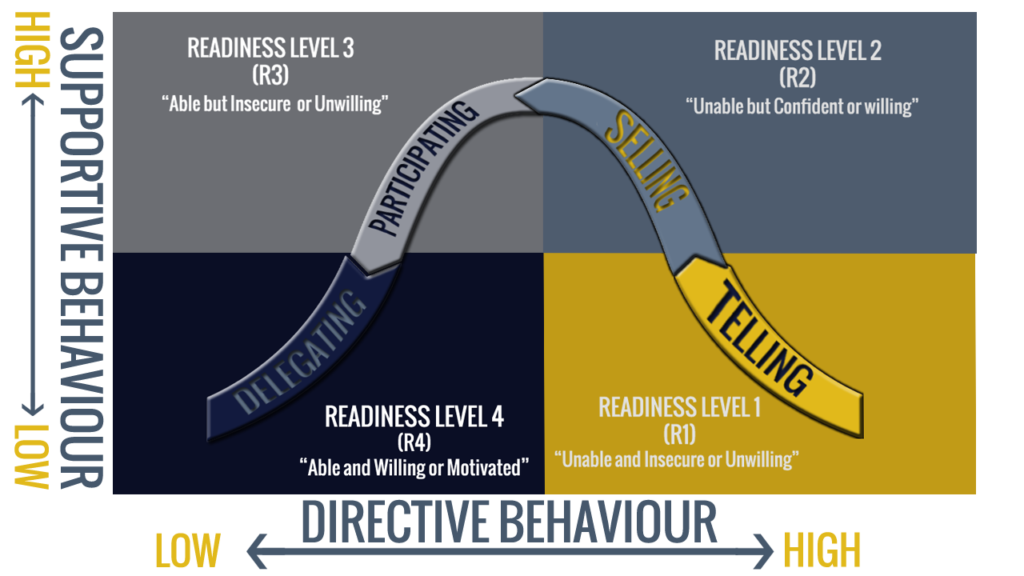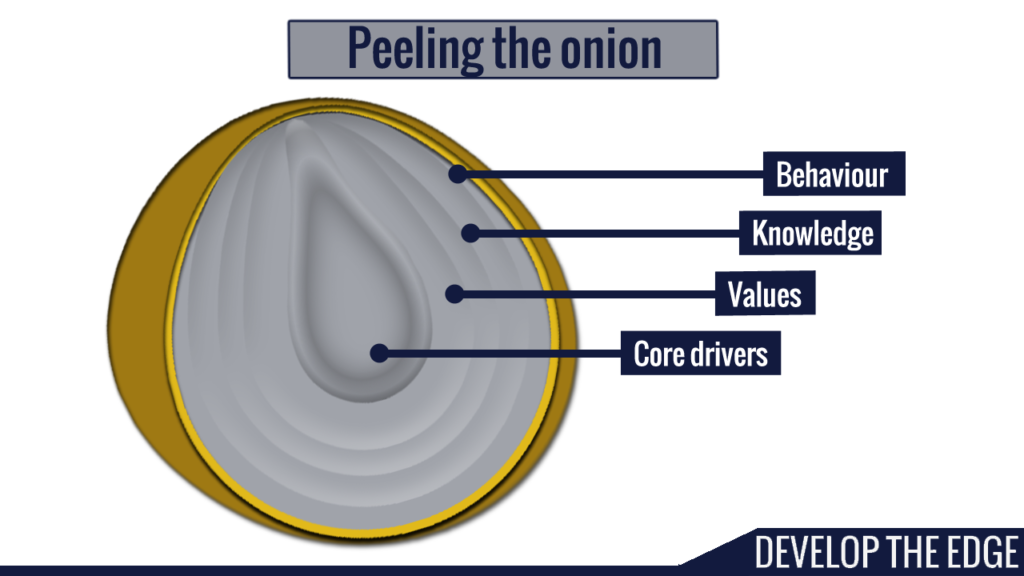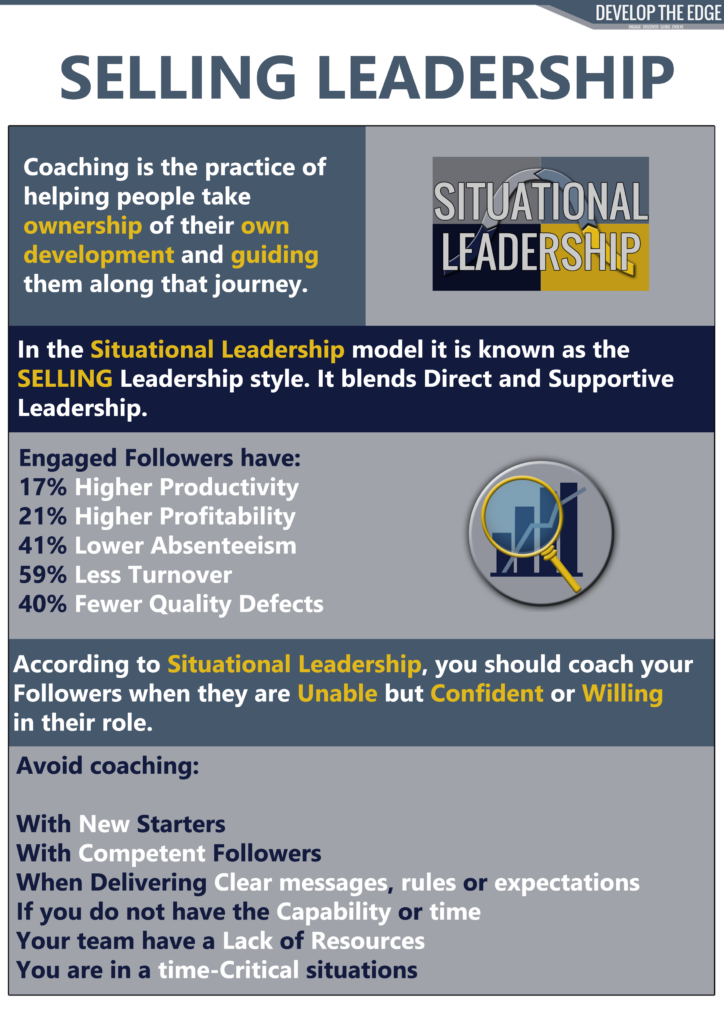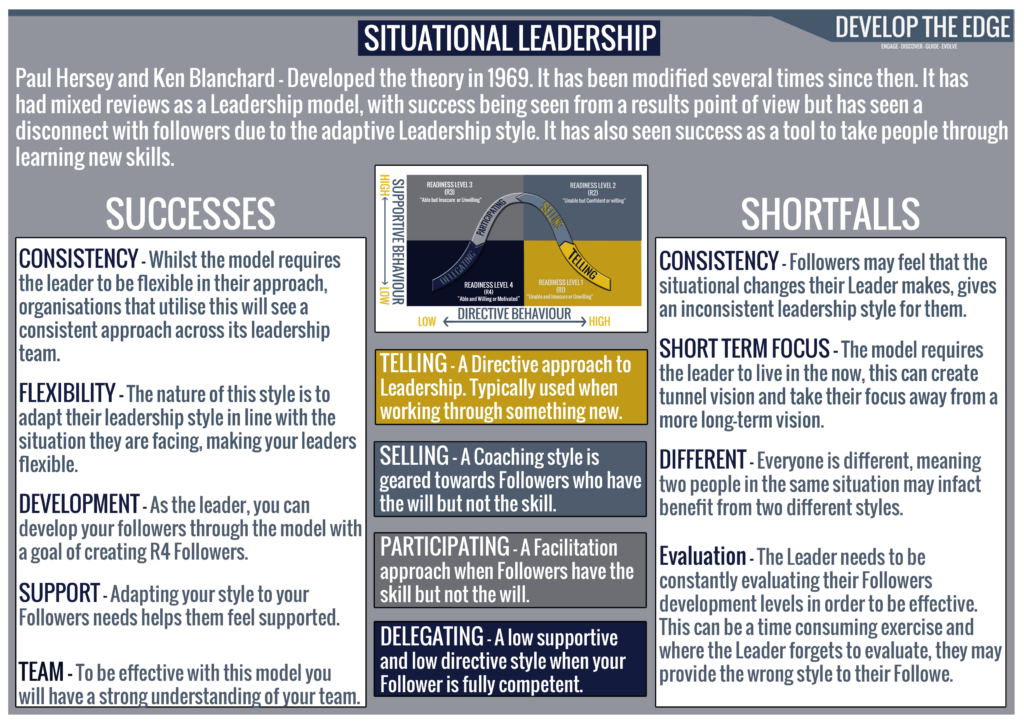Coaching at the wrong time can create tension between yourself and your team, it can create internal conflict and damage self esteem – this is definitely not the purpose of a good coaching session but the fact is, if you get the timing wrong with coaching, it can end in disaster for your team and your credibility. This article will help you avoid these negative consequences by providing a brief overview on what coaching is, why we use it and most importantly, when to use it.
This is the second of four articles where we will discover the four stages of Situational Leadership (based on Follower Readiness levels) and their accompanying leadership styles (Telling, Selling, Participating and Delegating). This article does not discuss how to coach but instead, will focus on the What, Why and most importantly When of coaching.
This article is based on the second Leadership style In Blanchard and Hersey’s Situational Leadership model, they referred to this coaching method as ‘Selling’ leadership, to be used with Readiness Level 2 Followers.

What is Coaching?
The first point we need to address is what do we mean by coaching? The Oxford English Dictionary defines coaching as:
“The process of training somebody to play a sport, to do a job better or to improve a skill.“
Sir John Whitmore defined coaching as:
“Unlocking a person’s potential to maximize their own performance. It is helping them to learn rather than teaching them.”
From these two definitions, we can understand that coaching is the practice of helping people take ownership of their own development and guiding them along that journey. It has elements of ‘telling’ and mentoring but the focus is to pull the answers from the coachee instead of giving them the answer.
Coaching tends to utilise a lot of open questions to provoke thoughts and encourage Followers to take a different perspective. My first Leadership mentor described coaching as peeling back an onion skin.
At the start, you have a problem or barrier – this is the skin of the onion. Your job as a coach is to ask questions in order to peel back each layer of the onion and get to the core of either the problem or the driving force of the person you are coaching. Once you have reached the core of the onion, you can be more effective at helping your coachee find their best way forward.

The Why of coaching
Now we have discussed what coaching actually is, it’s time to look at why we coach. The Gallup survey Re-Engineering Performance Management found that:
Only 2 in 10 employees strongly agree that their performance is managed in a way that motivates them to do outstanding work.
Quite worrying as a leader and a coach if 80% of your team felt that your leadership style didn’t manage to motivate them.
Further to this, whilst only 30% of employees strongly agree their manager involves them in goal setting. These employees are nearly 4 times
more likely to be engaged than other employees.
We can see then, that employees find being coached and involved in setting their own goals can significantly increase engagement and motivation levels. The links between engagement and high performance were outlined in another of Gallups publications State of the Global Workplace.
Here, they noted that businesses in the top quartile of engagement:
- Are 17% Higher in Productivity
- Are 21% Higher in Profitability
- Have 41% Lower Absenteeism
- Have 59% Less Turnover
- Have 40% Fewer Quality Defects
Than the bottom quartile of engagement.
Alongside the benefits of engagement, coaching your Followers also directly increases:
- Individual Productivity
- Morale
- Levels of Trust and Rapport
- Problem Solving skills
- Self-awareness (mind-sets, strengths, development opportunities etc.)
- Accountability
We can see then, how much of an impact great coaches can have on their people, their organisation and their end-user customers. It would make sense then, that we would want to coach all of the time right?
…Not quite.
When to coach
There are times when coaching may not only be the wrong tool to use but it may actually be detrimental to your follower, their level of engagement and their effectiveness. Coaching is a diverse and enthralling topic, the best leaders know not only how and why to coach but when to coach as well.
According to the Situational Leadership model, the coaching technique should only be used when dealing with a Readiness Level 2 (R2) follower.

An R2 (Previously referred to as an M2 and then a D2) Follower is someone who is Unable to do their work effectively but is Confident or Willing in their task.
This is someone who is still unable to complete all aspects of their role to a good standard but due to learning and developing, they have gained confidence in their abilities and in turn this has helped their drive or willingness to complete their tasks.
If we look at the Situational Leadership Model, Leaders need to use a mix of High Directive and High Supportive behaviour to help their R2 followers. If they just used directive leadership, you would damage your Follower’s confidence and if you just used supportive leadership, you may end up frustrating your Follower.
Why is this?
If you used all Directive leadership and told your Follower what they needed to do all of the time, you would likely damage your Followers confidence as well as your relationship with them. The reason for this is that an R2 follower is someone who believes they are fairly competent in their role.
Think about how you would feel (or have felt) if you had a good understanding of your role but you were being micro-managed?
Possibly:
- Frustrated
- Incompetent
- Under valued
- Un-engaged
- Bored
- De-Motivated
On the other side, if you just used high Supportive Leadership and no Directive, the Follower may lack direction. Remember, they are not fully competent yet and may need Telling in some instances. Delegating or purely Facilitating to this Follower may leave them feeling overwhelmed or have disastrous impacts to the outcome of your project.
Coaching here, means you are investing a lot of time in your Follower. You are mixing your Leadership style between Directive and Supportive behaviours in order to help your Follower grow.
When not to coach

If you would have told me that coaching wasn’t always the best method to use when I started leading, I probably wouldn’t have believed you. Everything I was taught or read pointed towards coaching as the acceptable feedback and development style for a Leader to use. Whilst we can clearly see the benefits of coaching in the right situation, in some situations it can actually be detrimental. Let’s take a look at some of the situations where coaching wont be the best style to use.
New Starters

That’s right! Our article on Directive Leadership goes into this in detail.
Think about when you first started a job, you would have no idea on what processes you needed to follow or how to be effective within your role. Therefore, unless it was a common sense answer, your Leader asking you ‘What do you do here?’ Or ‘what is the purpose of this step?’ Is likely to cause frustration instead of motivation, you simply can’t answer something that you don’t know the answer to! Of course, as your New Starters get to grips with their roles and processes, coaching will form a natural part of your interactions.
When your Follower is competent but unwilling or insecure.
As your follower grows in competence, they will need a lot less direction from yourself. There is a fine line between a Follower that needs Coaching and a follower that needs some Facilitation. Whilst this isn’t a big jump in leadership style, remember that coaching still includes a lot of direction and ‘Selling’ of ideas. A Follower who is competent will not need any direction but will need thought provoking encouragement to help build their confidence and will.
When you have a competent Follower, you need to encourage them to share their thoughts and ideas more freely. Outlining tasks and their purpose too much here may create friction and frustration with your follower as they will already know their tasks and purpose.
When your Follower is Able and Willing or Motivated

As a leader, this is where you want your Followers to be. They are fully competent and driven to do their work. They know what needs doing, why it needs doing and how they are best positioned to achieve their goals. Typically, you want to Delegate to these Followers as you will be confident they will deliver to the highest standard with minimal support or direction.
Just like the Able but Insecure or Unwilling Follower, coaching this person may lead to them feeling frustrated, micro-managed or incompetent. This kind of interaction can have devastating impacts to your relationship with them as well as their morale. In worst case scenarios, you risk losing the people you have invested time and energy into as they seek a position where they feel more valued.
The other impact here is to your time! Coaching takes a considerable amount of time and focus to do properly, if you are coaching Followers that don’t need coaching, you’re wasting your time as well as theirs. Instead of coaching these Followers, consider if you could get closer to your strategic objectives by being a better situational leader here.
Coaching this Follower may make them feel incompetent, thinking things like “Am I that bad at my job they need to spend this much time with me?” Or “Didn’t I deliver the last project well enough? Why are they testing my basic knowledge?” – this slippery slope will quickly see your Follower becoming insecure or unwilling, moving them from Readiness level 4 to Readiness level 3.

Delivering a clear message, rules or expectations

A Follower has just flaunted the rules, they have breached regulation, your client who was on site has witnessed them do this and now your Follower is joking about it with a colleague.
Does this Follower, your client and your organisation in this moment need a Leader to be highly supportive of that persons behaviour? Probably not…by all means tell the Follower WHY you have the expectations you do and why the rules and regulations are there but this is a feedback opportunity, not a coaching opportunity. This Follower needs to understand the consequence of their actions and this comes from a directive approach.
Your capability and level of support

Coaching requires a level of credibility, capability and support from the leader. If you haven’t invested time and effort in order to show your Followers you are there to help them, they may not be as receptive to coaching.
This isnt a blanket rule of dont coach, as this can help build that trust and support but be mindful that in order to get the best out of the coaching session, your coachee must understand you are doing it in their best interests, to help them and the organisation.
If you are not capable of supporting your Followers, committing time and energy to them, are you the best person to offer coaching? Do you need to develop as a leader here or would utilising a different coach be a better solution?

Lack of resources

If your team do not have the resources to get the job done, what value would coaching them have here? What is the point of coaching on your team’s performance where systems, hardware and software are not adequate enough for your team to perform effectively?
Think about if you had the ability to succeed in work, you are given a project that you can excel at but due to system resources you were unable to complete the work to your usual high standard.
A PC that keeps crashing, running so slow it is unable to run multiple applications and your requests for up to date equipment continually fall on deaf ears, can in itself, be enough to demotivate and frustrate people.
How would you then feel, if the project lead who is aware of the system issues, began coaching you on your performance? The engaging effect that coaching can have, would be lost here.
Resources don’t just stop at hardware or software issues though. Time, budget, facilities and human resources are all contributing factors to consider. Does this mean you expect your team member to under-perform?
Not exactly. Accountability and ownership are extremely important attributes for both a Leader and their Followers to have. Rather than looking to performance coach results here, support your team to think about what they CAN do. What opportunities these constraints and issues bring the team.
A useful tool here would be the ladder of accountability. Take a step back and an honest look at a situation where you haven’t been accountable, start at the bottom of the ladder below and see where you would rather be.

Time restricted or urgent situations

The fire alarm sounds, there is clearly an emergency happening. Your Followers look to you for guidance.
You calmly look them in the face and ask ‘what do you think we should do here?’
Coaching and facilitating can be great techniques to use where time is not of the essence, when an urgent decision needs to be made though, a more Autocratic and Directive approach is needed.
The same goes for any situation that calls for a quick decision. If you adopt a coaching style here, not only do you risk wasting time with this approach but you also risk losing your credibility. Coaching here will come across as weakness because it looks like you don’t know what you’re doing. Coaching your team when they are looking for guidance doesn’t meet your teams needs and makes you look inept as a leader.
Summary

What
Coaching is essentially the process of helping people take ownership of their own development and guiding them along their journey. According to the Situational Leadership model, this approach combines Directive and Supportive leadership.
Why
Coaching can aid in creating engaged employees. When people are engaged in their roles, they tend to be more productive, solutions orientated and less likely to be off work sick.
When
According to the Situational Leadership model, coaching is best suited when your follower is unable to do their task in the most effective way but they are willing to try or confident in their abilities. Coaching here allows you to guide your follower to take ownership of their own development and performance. It can channel their momentum into being a more able follower.
That said, there are times when coaching, despite its positive nature can be the wrong leadership style to utilise. The below are situations where there may be a better way forward:
- New Starters
- Competent Followers
- Delivering Clear messages, rules or expectations
- Your Capability
- Lack of Resources
- Time-Critical situations
Thank you for using your time and our resources to further your understanding and skill set. If you have any feedback, queries or requests please get in touch with us at: Connect@developtheedge.com
We have created the below resources for you to utilise. Click each item to preview the content and download it to your device on the go:
One page guide – Selling Leadership
One page guide – Situational Leadership
Reflection template – Selling Leadership in practice
Quiz – Selling Leadership








